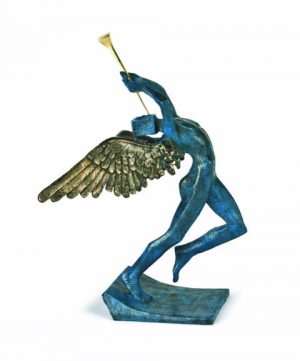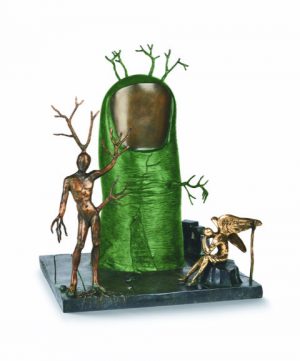The elephant, Dalí’s symbol of the future, is one of his favourite images, often typically depicted carrying objects on their backs. Dalí subverts the idea of the elephant being heavy and strong, by giving it impossibly long legs. It is an example of pure Daliesque whimsy, a fantastic image created by juxtaposing the immense weight with the fragility of the thin joints. There is a sense of otherworldliness as Dalí’s elephants defy the laws of nature moving effortlessly, almost gracefully.
These spindly legs remind us of stilts and crutches, which Dalí used so often in his work.
The elephant was a recurring theme, first appearing in his 1944 painting Dream Caused by the Flight of a Bee Around a Pomegranate a Second Before Awakening.
The Triumphant Elephant is one of the artist’s most iconic and instantly recognizable images.
The figure resting lightly on the pachyderms back is an angel, an image which featured widely in Dalí’s oeuvre. In Dalinian psychology, the messenger represents the subconscious that guides man through life. The elephant raises his trunk triumphantly as the jubilant herald mirrors this action trumpeting success and hope for the future.
Dalí’s fascination with elephants was such that when Air India commissioned him to create a souvenir in 1967, Dalí presented a porcelain ashtray; a swan which transformed into an elephant when turned upside down. In lieu of payment, the eclectic Spaniard asked for a baby elephant which was duly flown from Bangalore to Geneva.
Date: conceived in 1975, first cast in 1984
Material: bronze
Technique: lost wax process
Edition size : 350 + 35 EA
Height : 53 cm
Edition : patina green
Maquette: original gouache, Triumphant Elephant, 1975
Direct intervention (created by Dalí): the idea, image, and original maquette
Indirect intervention (created by artisans): lost wax process and patina






